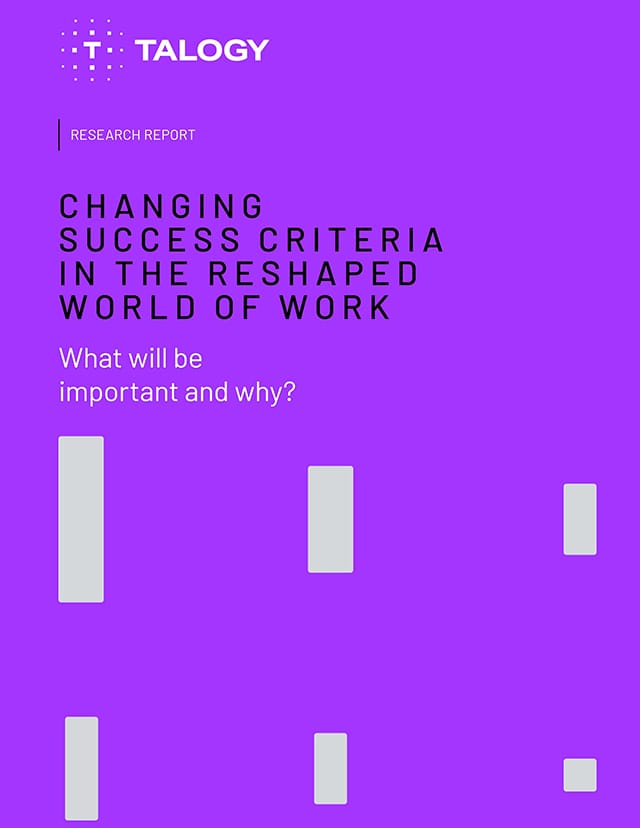Written by Ted Kinney, Ph.D., VP of Research and Development
Previously published by PSI Talent Management or Cubiks, prior to becoming Talogy.
Recovery is coming. However, with so many drivers of change converging at the same time, it’s going to be difficult for organizations to manage their talent systems. So, it’s important to determine if your organization is positioned to get back to business better.
Many of the trends driving change in organizations are not new. From technology advances that impact job design like increased automation to gig economies that challenge the traditional concept of a job to the already present shift to remote workforces, our world’s organizations were already facing rapid change. The pandemic merely pressed the fast-forward button on these.
As we move into recovery, successful organizations must also fast forward their talent systems and adapt to get ahead of the trends. The organizations who adapt will come out of recovery stronger.
Below are key strategies that will assist organizations as they emerge from the effects of the crisis.
Attract the Best
Attracting the right candidates to your job openings is often overlooked. Most employers will find themselves with many more candidates than they had a few months ago. Leveraging technology to help the right candidates apply, while discouraging those candidates with a lower likelihood of fit, is important. In times of high unemployment, it is important to manage efficiency by helping job seekers evaluate their fit before applying to jobs so that the candidate pool is comprised of people who have been introduced to the culture and understand their fit. In the recovery world, using an attraction tool that communicates concepts like safety culture and remote job designs will help target the right people.
Measure the “Right Stuff”
Make sure you are measuring “the right stuff” with assessment content specifically designed for your organization. Another critically important consideration as you evaluate talent systems and assessment programs is how well the assessment targets the specific competencies that are critical for your specific and unique recovery context. It’s important to ensure that assessment solutions measure what is important for your organization’s culture and performance and not just what the assessment vendor tells you is important.
Your assessment partner also needs to have a technology platform that allows you to configure solutions that use only the content that is relevant to your jobs. In addition, custom scoring will help you make decisions for your organization to specifically meet the challenges and goals for your talent selection program.
Design an Agile Process
Additionally, because you need to make these critical hiring decisions with less face-to-face time with candidates, organizations have to ensure that their hiring systems are remote capable, but still robust. Technology-enabled tools will help you structure such a selection process.
For example, video interviews eliminate the safety hazards of face-to-face interviewing, remove scheduling bottlenecks, and allow you to leverage artificial intelligence to reduce the time spent processing a large number of candidates during post-pandemic rehiring.
For clients who simply are not able to proctor assessments in testing centers due to health hazards, remote proctoring technology allows organizations to monitor test takers and identify suspicious and inappropriate behavior among remote participants.
Enhance Well-Being
With post-COVID-19 budgetary pressures, it will be difficult to find time and resources to efficiently support the well-being of your employees. Nonetheless, the need has never been greater as employees face a myriad of both work-related and non-work-related challenges through recovery and beyond. Well-being interventions from hourly through executive roles will help make sure that your workers return ready to perform.
Develop New Skills
Job design changes have been thrust upon organizations due to the pandemic. These changes have put people in roles that they may not have chosen or may not fit into under normal circumstances. Effective organizations take the time to develop these employees and assist in upskilling them so they are able to thrive in their new job contexts.
As we look to the future of work and the new labor market, it’s likely that remote work is here to stay more broadly. However as offices open back up, it’s likely that 50 to 60 percent of these jobs will remain remote in the post-pandemic workplace.
Some employees will naturally thrive in this remote workplace. Others will find ways to cope. And others may have difficulty adjusting to the reduced face-to-face communication. Using tools to help employees learn about themselves when it comes to their strengths and areas of development with regard to remote work and then providing developmental feedback and suggestions about how to work effectively in this new context could be the key to maintaining and improving productivity over the years to come.


